Beef Bulgogi (Authentic Korean BBQ Beef)
Beef bulgogi is all about tender, juicy beef marinated in a soy, garlic, and pear sauce, then pan-seared until perfectly caramelized. It takes a little marinating time, but this make-ahead Korean BBQ favorite always delivers deep, savory-sweet flavor that tastes straight from a Korean grill.
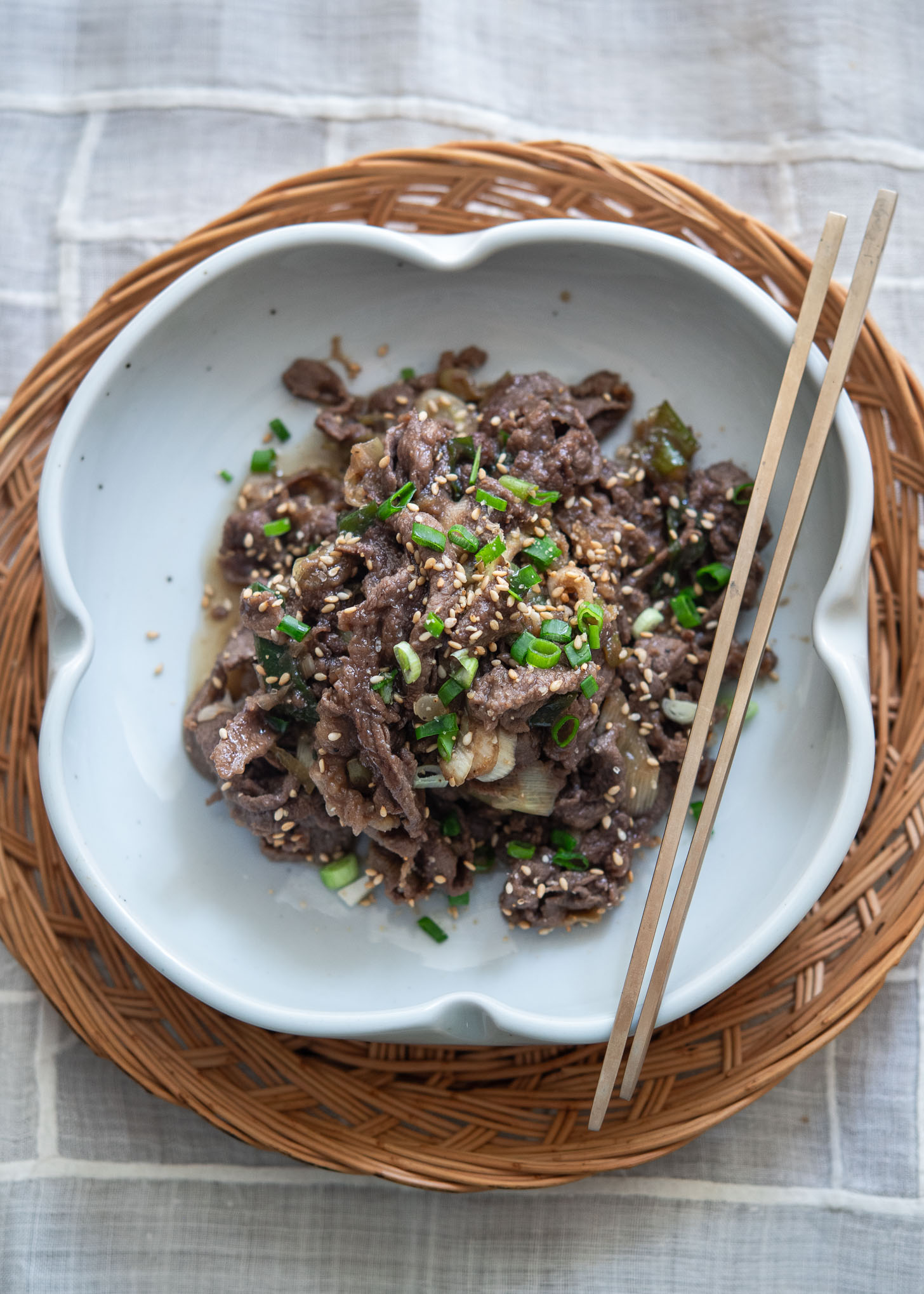
Bulgogi (불고기) is one of Korea’s most iconic dishes; thin slices of marinated beef cooked quickly over high heat until caramelized and tender. It’s savory, slightly sweet, and deeply satisfying — a staple at Korean BBQ tables and in home kitchens alike.
This recipe is the way my mom used to make it — simple, balanced, and full of flavor. She always used thinly sliced ribeye or sirloin, marinated with grated pear, garlic, and a mix of two types of soy sauces — her secret for a deeper, richer taste. She never added vegetables like carrot or zucchini, letting the beef take all the glory. I still make it her way, and it never fails.
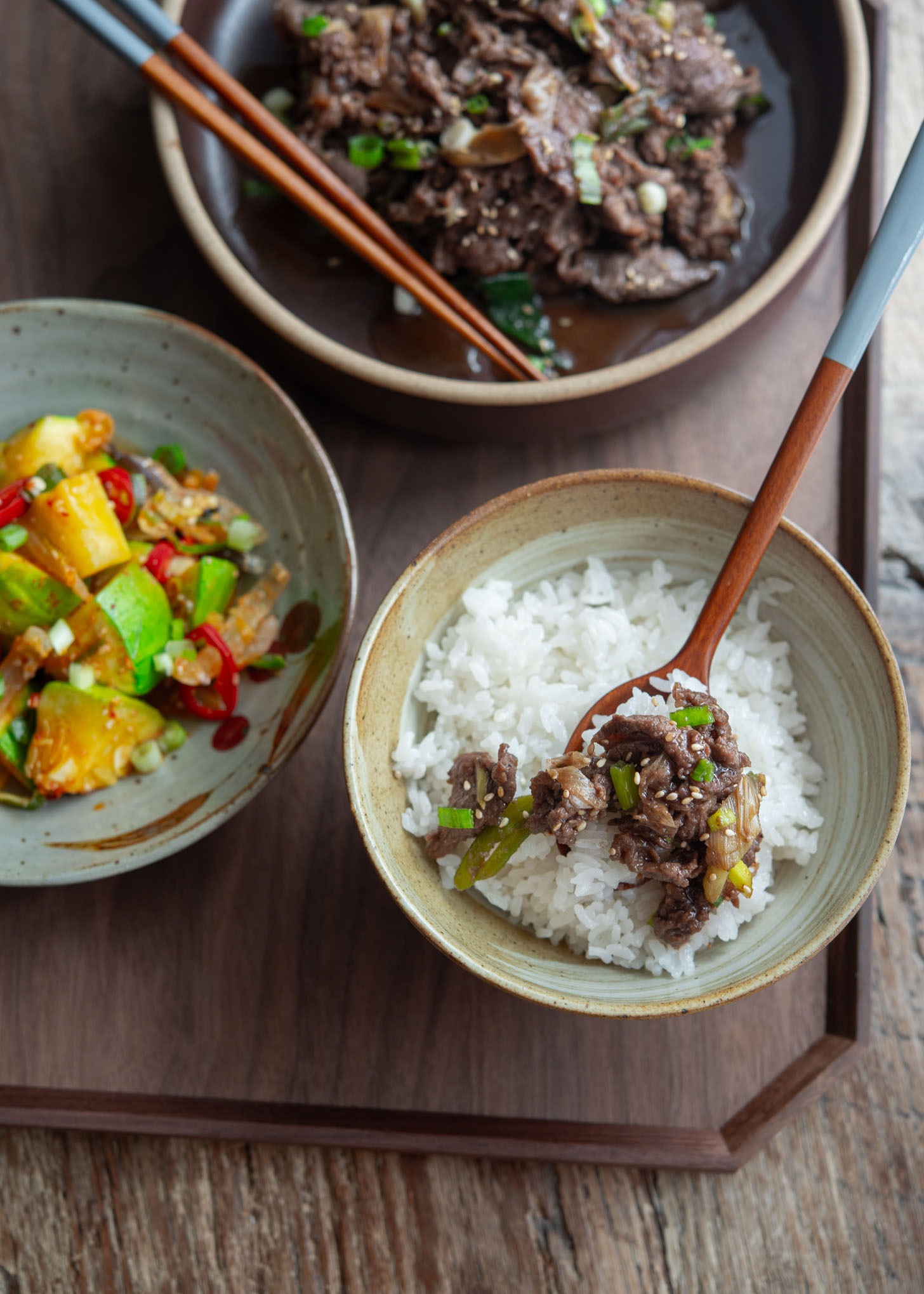
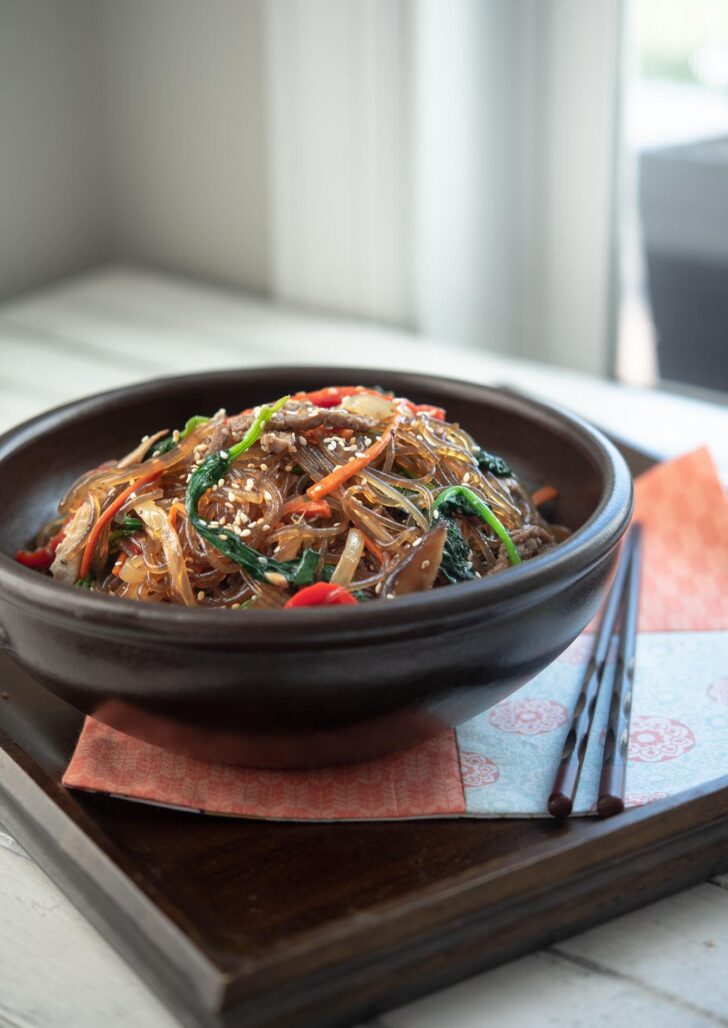
Get new recipes via email:
What I love about this bulgogi recipe is that it feels special but comes together fast. With just a few ingredients and a quick marinade, you can recreate that smoky-sweet flavor at home — no fancy equipment needed.
If you’re planning a full Korean meal, you can browse my Korean main dishes collection for more ideas that pair well with bulgogi. It’s a great place to find simple, weeknight-friendly dishes that feel just as comforting.
Whether you’re firing up the grill or using a skillet, I’ll show you exactly how to make authentic Korean beef bulgogi with ease.
If you’re short on time, try my ground beef bulgogi. It uses ground beef instead of sliced beef, so it comes together faster and still hits the spot for a quick weeknight dinner.
My Favorite Beef Cuts for Bulgogi
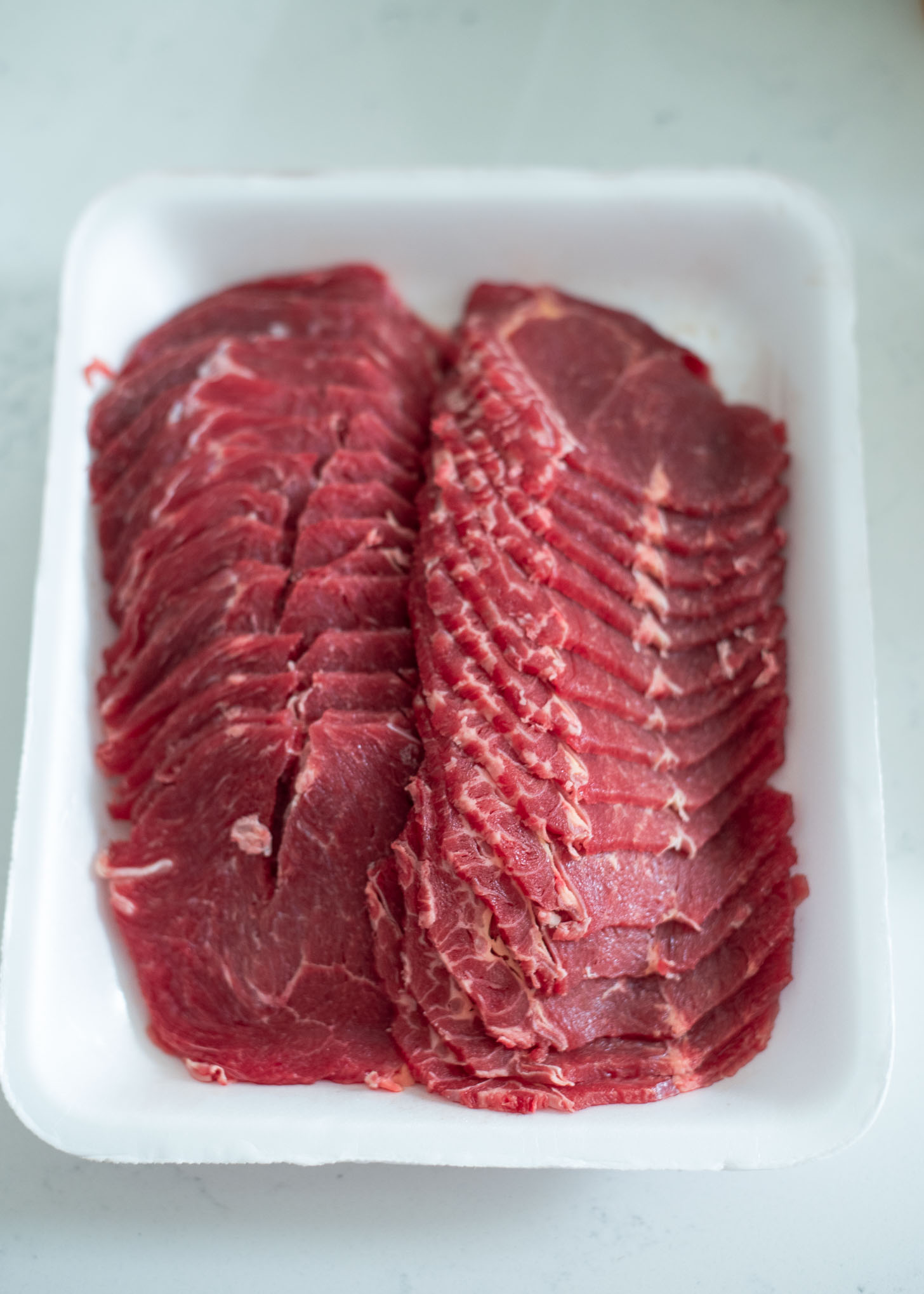
With all the other beef cuts I’ve tried for making bulgogi, I find that thinly sliced ribeye or sirloin works the best. These cuts are tender, have the right amount of marbling, and soak up the marinade beautifully. For the juiciest bites, always slice against the grain.
A little tip: partially freeze the beef for about an hour before slicing—it makes it much easier to get those perfect, paper-thin slices!
Shortcut: Many Korean grocery stores sell pre-sliced frozen bulgogi beef. It’s a great option if you want to skip slicing and jump straight to marinating!
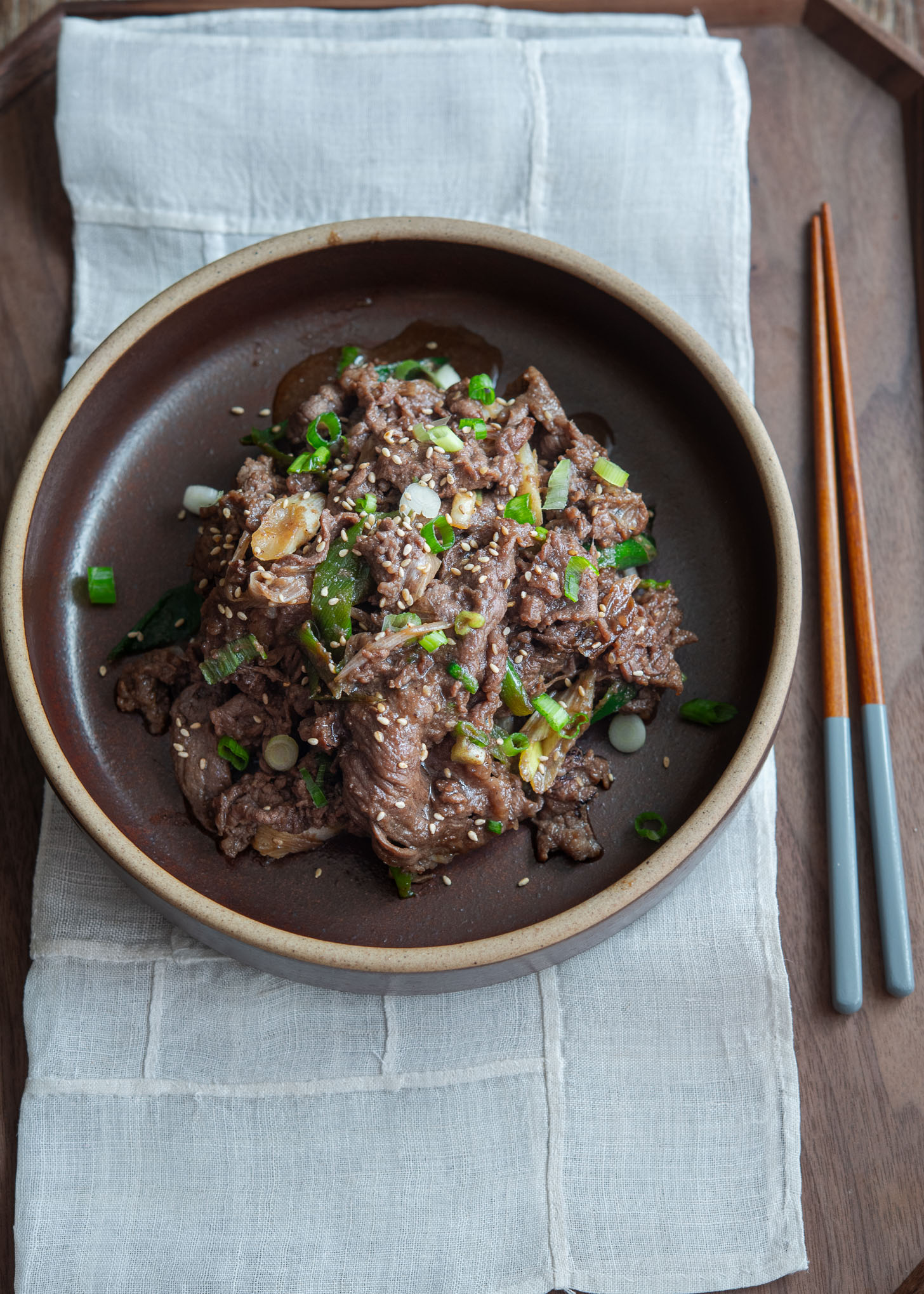
How to Make Bulgogi (Step-by-Step Guide)
Making authentic bulgogi at home is easier than you might think. Start with a simple but flavorful marinade (homemade bulgogi sauce). Here’s what you’ll need and how to bring it all together.
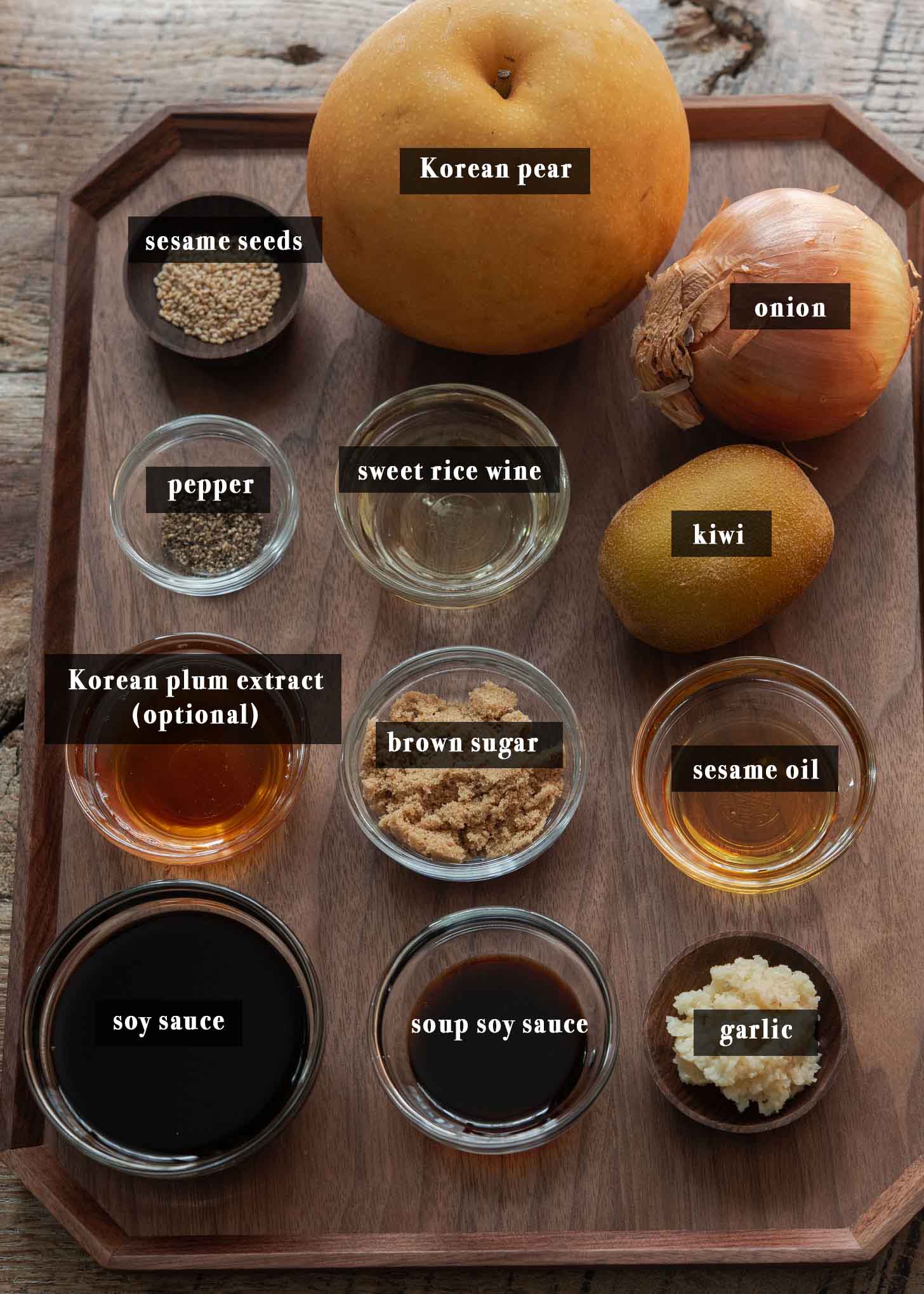
1. Gather the Ingredients. Both regular soy sauce and soup soy sauce, brown sugar, pear, kiwi, rice wine, and other aromatics.
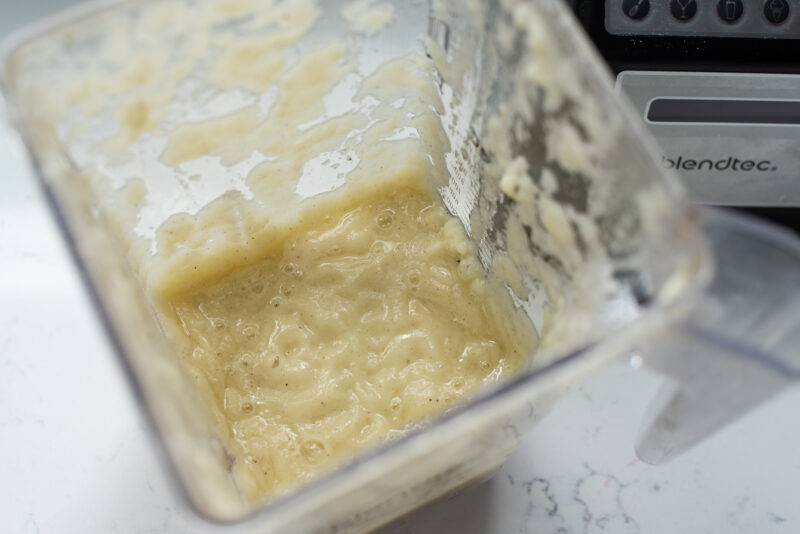
2. Puree the Fruits and Aromatics. Blend pear, kiwi, onion, and garlic until smooth — this forms the base of the marinade and helps tenderize the beef.
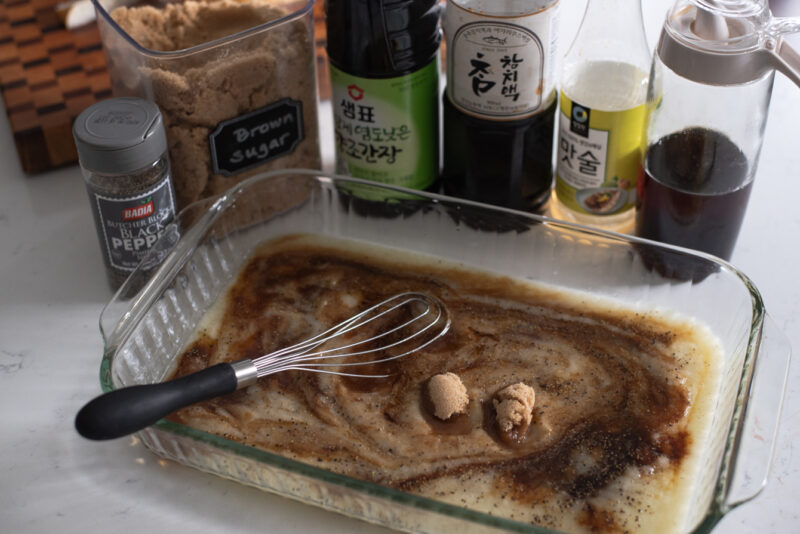
3. Make the Marinade. Mix the puree with soy sauces, sugar, sesame oil, and other seasonings in a large dish or container. I use a 9×13-inch Pyrex dish.
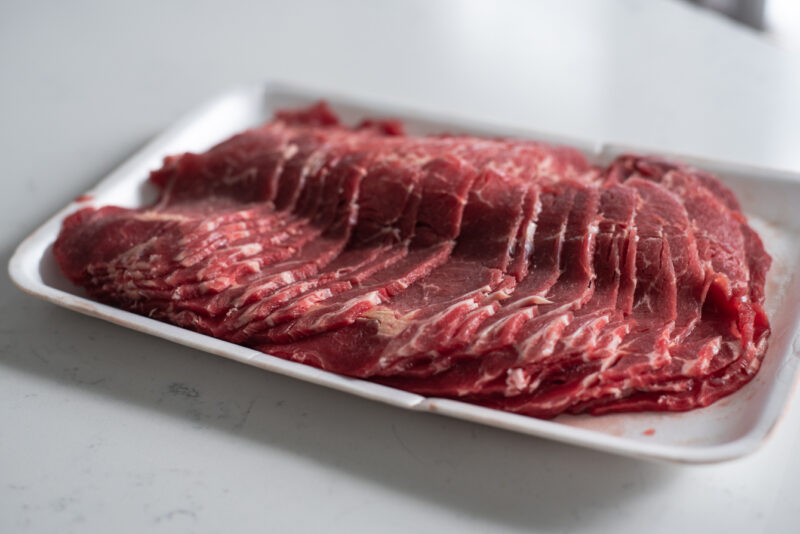
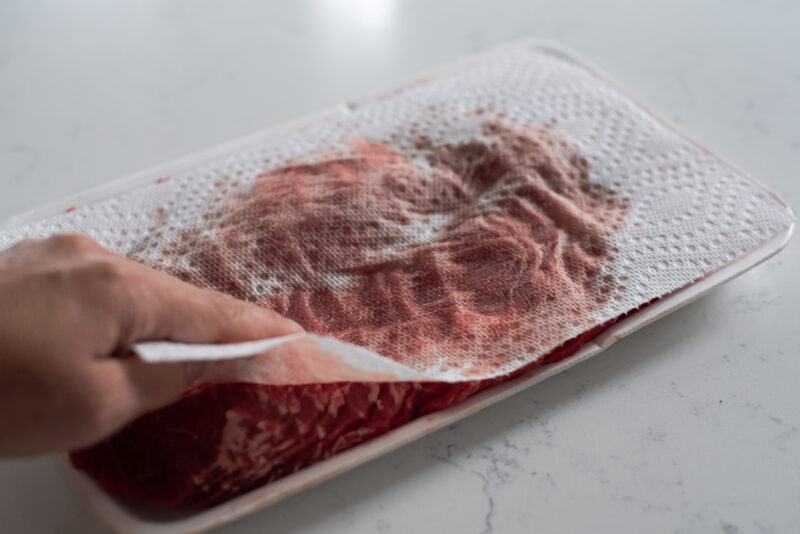
4. Prep the Beef. Pat the sliced beef with paper towels to remove excess red liquid, especially if previously frozen. This improves flavor and helps avoid any off odor.
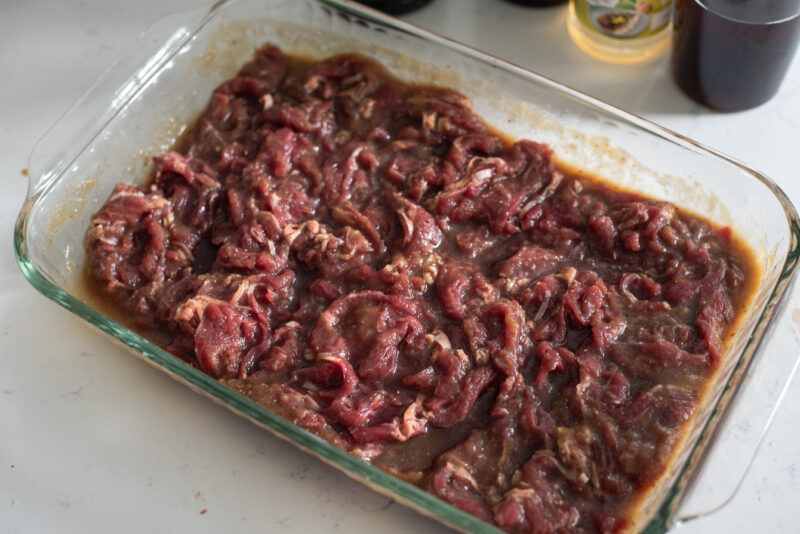
5. Marinate the Beef. Add the beef to the marinade and toss to coat well. Cover and marinate for at least 1 hour — or overnight for deeper flavor.
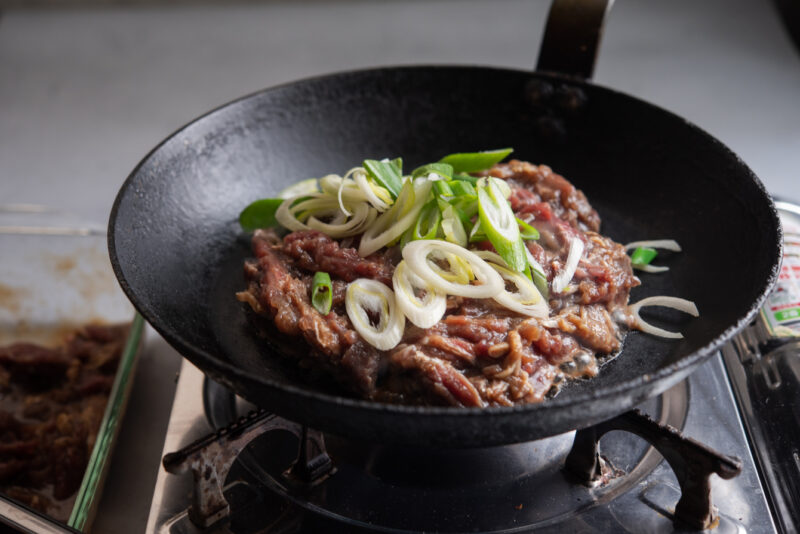
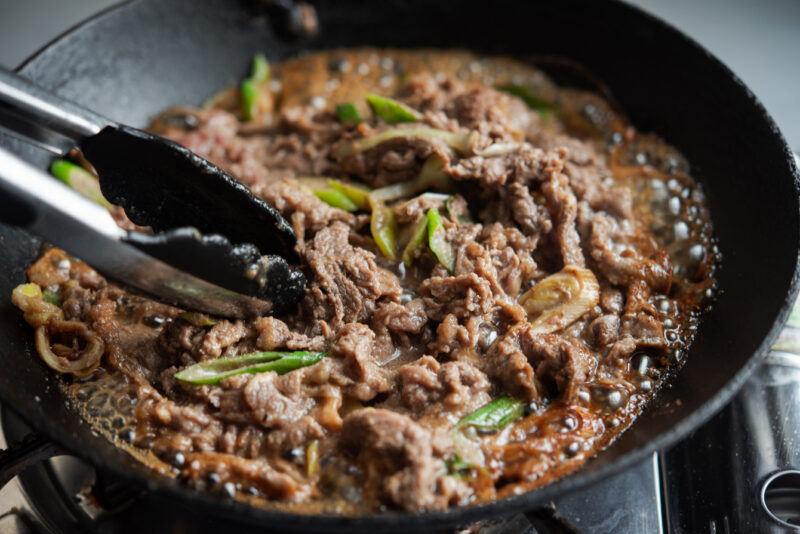
6. Cook the Beef. Sear the marinated beef with green onion in a hot skillet, no oil needed.
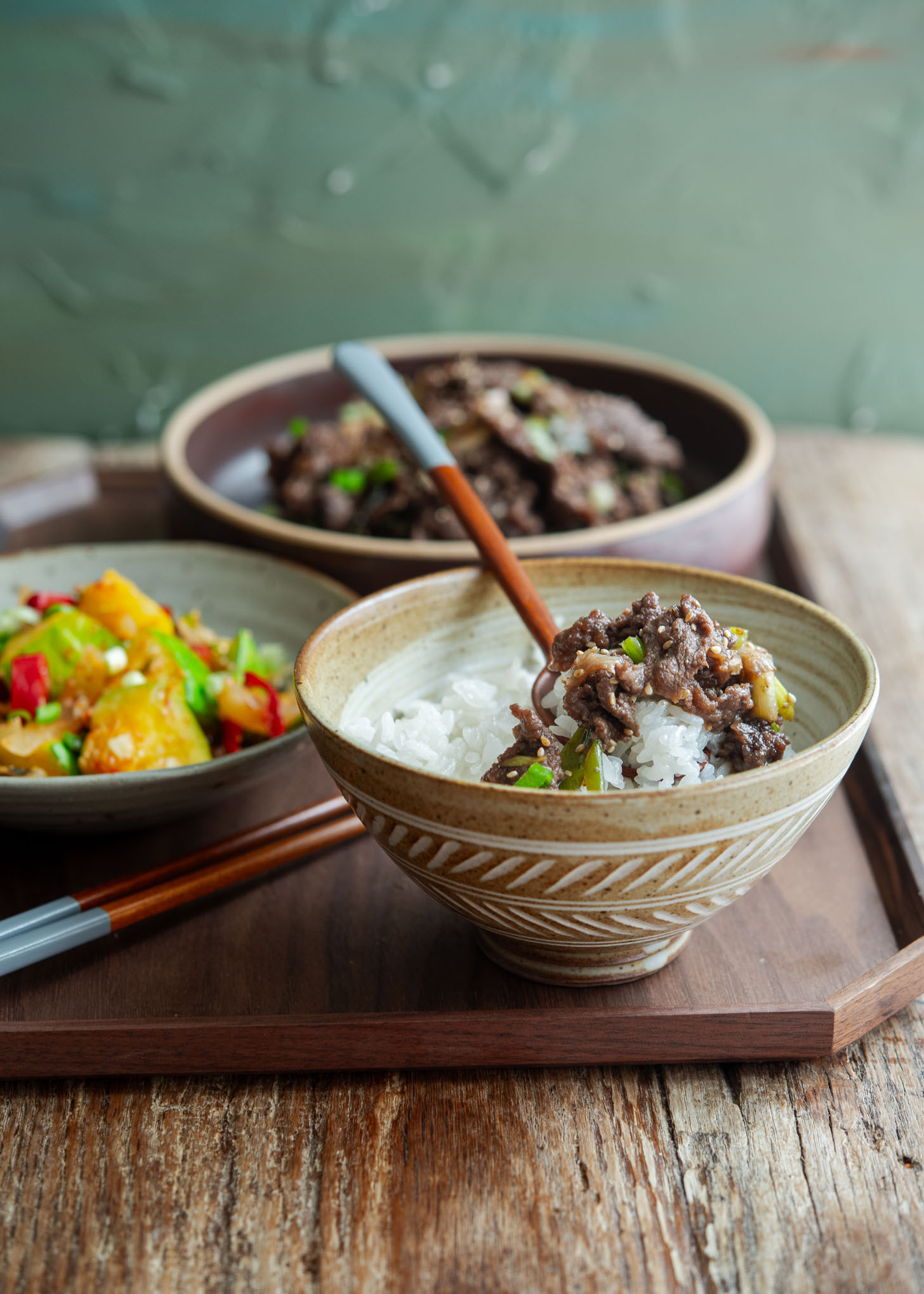
Serving Ideas
Korean beef bulgogi is often served over a bowl of white rice for a simple, satisfying meal. Add a side of kimchi or any Korean veggie dish to round it out.
For a fun, hands-on experience, I suggest wrapping the beef, rice, and green onion salad in lettuce leaves with a dab of homemade ssamjang. It’s a crowd favorite and absolutely delicious.
If you have leftovers, add some to your bibimbap for an extra boost of protein — it doesn’t get better than that!
I also share a Seoul-style bulgogi in my cookbook Korean Cooking Favorites — a brothy, mushroom-forward version that’s popular in many Korean homes. It’s cozy, flavorful, and one of our family favorites.
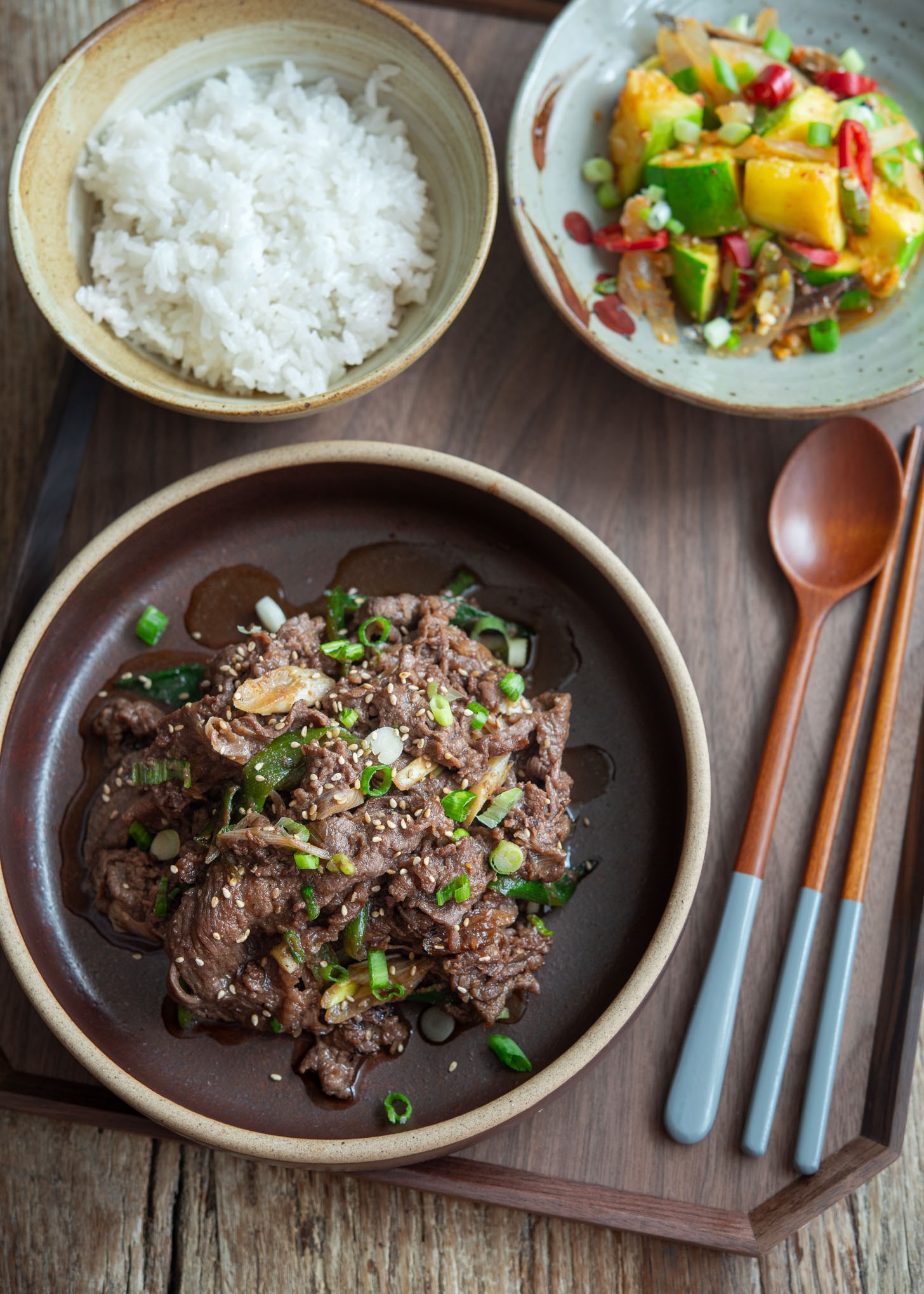
Love this recipe? Rate it and share your experience in the comments below! On Instagram? Tag me to showcase your creation. For more delicious recipes, subscribe to our newsletter!
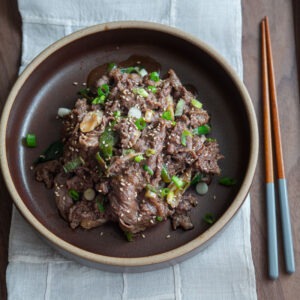
Beef Bulgogi (Korean BBQ Beef)
Recipe Video
Ingredients
- 2 lb (900 g) beef sirloin or rib eye , thinly sliced, about 1/8-inch thick
- 1 Asian leek or 3 green onion, sliced
Bulgogi sauce
- 1/2 (about 100 g) large Asian pear , peeled and diced. See note for substitution
- 1/4-1/2 (about 35 g) kiwi, peeled and diced. See note below
- 1/2 (about 100 g) large onion , diced
- 4 cloves garlic
- 5 tbsp (75 ml) soy sauce
- 1 tbsp (15 ml) Korean soup soy sauce (gukganjang)
- 2-3 tbsp (25–40 g) light brown sugar
- 2 tbsp (30 ml) sweet rice wine (mirim)
- 2 tbsp (30 ml) Korean plum extract (maeshil cheong), optional
- 1/2 tsp black pepper
- 1 tbsp (15 ml) sesame oil
- 2 tsp (6 g) toasted sesame seeds
Instructions
To marinate beef
- To make bulgogi marinade, put pear, kiwi, onion, and garlic in a blender and process until very smooth.
- Pour the onion/fruit puree into a large shallow pan – a 9×13-inch pyrex baking pan (with lid) is perfect for this. Add soy sauce, Koran soup soy sauce, brown sugar, rice wine, Korean plum extract (if using), pepper and sesame oil; mix well. You can make this marinade sauce ahead of time and keep it in the refrigerator for up to 1 week.
- Dab the beef with a paper towel to wipe out extra liquid on the package if there's any. Separate the beef slices and add them to the marinade sauce. Toss gently by hand to combine everything with a slight massaging motion. Cover and marinate for at least 1 hour or up to overnight.
To cook bulgogi
- Heat a skillet very hot over medium-high heat. Do not add any oil! Add the beef. You can add sliced Asian leek or green onion on top. The beef should sizzle as soon as it touches the hot skillet. Let the meat cook in its own juice. Toss the meat around to cook evenly and thoroughly, about 2-3 minutes. It should cook very quickly.
- Sprinkle with sesame seeds and green onion to garnish. Serve warm with rice and a vegetable side dish.
Notes
- Freeze beef for 20–30 minutes before slicing for easier, thinner cuts.
- Use High Heat. A hot skillet gives bulgogi its signature caramelized edges and flavor.
- Don’t Overcrowd the Pan. Cook in batches to avoid steaming the beef.
- You can add thinly sliced carrot or zucchini if you’d like a heartier version, but this recipe keeps the focus on the beef for a more traditional Korean flavor.
- While pan-searing is the easiest method, bulgogi tastes incredible grilled over open flames or broiled in the oven. For grilling, use a grill pan or outdoor grill over high heat to get caramelized edges and smoky flavor. If using the broiler, spread the marinated beef in a single layer on a foil-lined baking sheet and broil for 4–6 minutes, flipping once, until nicely browned.
- To make ahead, store marinated beef in the fridge for 3–4 days or freeze up to 3 months. Leftovers reheat well in a skillet or microwave.


Hi there! Thanks so much for sharing your recipe! I enjoyed the process and followed your direction to a T. Unfortunately it was a bit too sweet (which I will lessen the sugar next time) but also I was disappointed that it was not tender enough. I did use pear and kiwi and marinate for at least 24 hours. My daughter was disappointed that it was not as tender as what she had at my friend’s house. What could I have done wrong? Years ago, I made a bulgogi marinade but it was over tenderized so the texture was not really good. Would love your feedback…
Hi Kate
I’m sorry to hear that your bulgogi isn’t as tender as you’d like. Without knowing the specific type of beef you used, pinpointing the exact issue can be challenging. However, using a tender cut of beef, such as sirloin or ribeye, that has been sliced against the grain can significantly enhance the tenderness of your bulgogi. The thickness of the beef slices also plays a crucial role. In traditional Korean cuisine, beef is typically sliced very thinly, usually to about 1/8-inch or even less. It’s so thin that it tends to tear as you mix it with the marinade.
Another tip I would suggest is to bring the beef to room temperature before adding it to a hot skillet. And yes, marinating the meat for too long with these fruits can cause the exterior to become mushy or negatively affect its texture due to protein breakdown. I hope this helps. Thanks!
What other kind of vegetables can I put in it
You can add carrot, zucchini, green pepper and extra green onion to this recipe. But mindful that adding extra veggies will thin out the bulgogi taste from the meat. Thanks!
What other veggies can I put in it
This is a staple in our house! My husband requests it weekly!!
Yay! So happy to hear that!
Is the old recipe still available? This was my go-to bulgogi recipe and I noticed it changed a lot! Added kiwi, skipped the myeolchi broth step, etc. While I’m sure this version is delicious and a little less labor intensive, it’s the version my Korean husband approves of!
Hi Andrea
The major difference between the two is that the old version has anchovy broth added. You can add 1/2 cup of anchovy sea kelp broth to the marinade. You can skip the kiwi, or used crushed pineapple (2 tbsp) instead. If you skip the kiwi, make sure to marinate overnight. The old version also uses mushroom and onion as an additional topping. You can either cook together with bulgogi, or saute them separately and top over bulgogi. Hope this helps.
I had my first taste of beef bulgogi this past summer, and it has become my favorite way to eat beef sirloin! Now I’m out camping, and introducing new friends to authentic Korean dishes!
I had a craving for bulgogi and this hot the spot!! The flavors were incredible, you’d never know there was pear and kiwi, it all worked so well!
Hi Annie
I’m glad that this bulgogi satisfied your craving. Yes, the pear and the kiwi does the wonder to make the beef more flavorful. Thanks for the comment!
Fabulous recipe! Thank you for this. It tasted just like I remember from living in South Korea as a kid.
I absolutely love Korean culture. Especially the food. It’s so yummy. 🙂
I haven’t tried this dish yet, but I’ve made japchae 3 or 4 times for my family. I am getting pretty good at it. I am so excited to learn more about the cuisine.
Are there any specific recipes that you suggest for a beginner cook? (I am still a teenager, ehehe)
Thank you so much!!
Hi Emily
You impressed me. I am so happy to know that you are getting good at Korean cooking. Here are a few recipes that I suggest you to try.
Spicy Pork bulgogi: https://www.beyondkimchee.com/spicy-korean-pork/
Chicken Bulgogi: https://www.beyondkimchee.com/chicken-bulgogi-korean-chicken-bbq/
Tteokbokki (spicy rice cakes): https://www.beyondkimchee.com/spicy-korean-rice-cakes/
Korean Army Stew: https://www.beyondkimchee.com/korean-army-stew-budae-jjigae/
Ramen Stir-Fry with Vegetables: https://www.beyondkimchee.com/10-minute-ramen-stir-fry-vegetables/
Korean Honey Garlic Chicken Wings: https://www.beyondkimchee.com/korean-honey-garlic-chicken-wings/
Kimchi Fried Rice: https://www.beyondkimchee.com/kimchi-bacon-fried-rice/
Pan-Fried Tofu: https://www.beyondkimchee.com/pan-fried-tofu/
Easy Kimchi Recipe: https://www.beyondkimchee.com/easy-cabbage-kimchi/
Keep up the good work! Don’t hesitate asking any question if you have.
Oh this looks terrific! I love Korean BBQ and Bulgogi, so thank you for sharing the recipe adopted to a pan!
Fantastic, and surprisingly flexible. I didn’t have a pear or kiwi so substituted a grated apple. I think it did the trick. I also used london broil sliced thin. If was still delicious.
My hubby loves bulgogi — such a delicious and flavourful meat! I wish I can have some right now!
Terrific post! I’m lucky in that my local supermarket sells thinly sliced beef that’s appropriate for this dish — so less work for me to do. 🙂 Haven’t made this dish in what seems like forever, and now you have me craving it. 🙂 Really good stuff — thanks.
Thanks so much for the recipe. I only have regular soy sauce so for the marinade I am sure I need less. Any suggestion how many tablespoon needed and do I need to add water maybe to make it 7 tbsp?
The love story you want is Sleepless in Seattle. The recipe is awesome. Can you now please give me your ssamjang recipe?
This looks absolutely deelish and I’m going to make it soon! I love the taste of ginger, would adding a little hurt anything?
Adding a just little bit of ginger will enhance bulgogi nicely. Go for it.
Gawd that sounds delicious… bulgogi at a Korean BBQ place is still the most delicious meat memory I’ve ever put in my mouth… yours looks divine. When I can eat again I will be trying this recipe for sure.
This was divine…..I think your special sauce and not adding the veggies right away helped make this one of the most beautiful bulgogi ever!
thank you again
Michel
Hi,
I made your bulgogi recipe for a party I hosted this weekend. It was soooo delicious, and a big hit with my guests!
My husband can’t wait for me to make it again. Thank you!
Jenny
Your blog, all of it, is food porn to me. <3
Thank you!
Yes.
Just went to a Korean shop today looking for dried sea kelp but found a dried sea tangle….are these two the same?
this looks yummy..I'll try to cook this next time 🙂
This is the best Bulgogi I've ever had. Thanks for sharing.
Please let me know how he thinks. Hope he likes it.
It looks absolutely delicious! I will make it tonight and let's see what my Korean husband has to say about it 🙂
Thanks sweetie. They were mighty tasty.
I would never tire of bulgogi and yours look yummylicious!!!